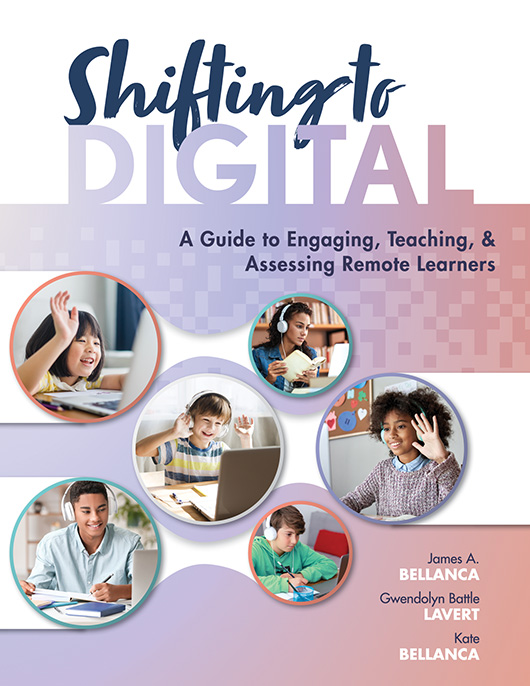Free Reproducibles
Shifting to Digital
A Guide to Engaging, Teaching, and Assessing Remote Learners
Rely on Shifting to Digital to deliver clear and concise answers to all of your remote teaching questions. This comprehensive guide provides specific strategies for planning high-engagement instruction, handling technology, assessing collaboration and assignments, and more. You’ll also gain access to a helpful list of digital tools, along with online-specific lessons and projects for various subjects.
Benefits
- Learn how to engage and manage multiple students online at one time.
- Create effective lesson plans that incorporate synchronous and asynchronous instruction based on best-practice cooperative learning and project-based learning.
- Gauge students' executive function and increase their self-direction—a crucial part of online learning.
- Understand how to best teach and support English learners and students with special needs.
- Plan communications for students, parents, and guardians that address technology procedures, expectations, and privacy.
TABLE OF CONTENTS
Chapter 1: The Technology to Master
Chapter 2: Instructional Design for Virtual Learning
Chapter 3: Digital Documents
Chapter 4: Mindful Engagement in Digital Classrooms
Chapter 5: Positive Interaction and Social-Emotional Learning
Chapter 6: Feedback
Chapter 7: Assessment in a Digital Environment
Chapter 8: Students With Special Needs
Chapter 9: Communication With Parents and Guardians
REPRODUCIBLES
Introduction
- Guiding Questions
- Instruction Idea Gathering
- Connecting Dots Between Experience and Inexperience
- Brainstorming Chart
Chapter 1
- Figure 1.3: Video Conference System Detail Collection Form
- Figure 1.4: Teaching Workstation Checklist
- Figure 1.5: Workstation Checklist for Students
- Figure 1.6: Joining Class Checklist for Students
- Students’ Digital Skills
Chapter 2
- Figure 2.2: Responsibility Roster template
- Resources, Activities, Support, and Evaluation Planning and Assessment
Chapter 3
- Figure 3.3: Guiding Rubric for Assessing Students’ Portfolio Management
- Figure 3.4: Student Self-Assessment for Portfolio Management
Chapter 4
- Figure 4.1: The Looks and Sounds of Autonomy—Early Elementary-Grade Guiding Rubric
- Figure 4.2: The Looks and Sounds of Autonomy—Upper-Grade Guiding Rubric
- Figure 4.7: Open-Ended Reflection on Teamwork
- Figure 4.8: Guiding Rubric with Team Agreement
Chapter 5
- Figure 5.7: Problem-Solving Template for a Restorative Conference
- Figure 5.11: Restorative Discussion Template
Chapter 6
Chapter 7
- Figure 7.2: Elementary-Level Example of a Cooperative Learning Assessment Template
- Figure 7.3: Secondary-Level Example of a Cooperative Learning Guiding Rubric
Chapter 9
SUGGESTED RESOURCES
BOOKS
- Bellanca, J. A. (Ed.). (2015). Deeper learning: Beyond 21st century skills. Bloomington, IN: Solution Tree Press.
- Bellanca, J. A. (2021). Personalized deeper learning: Blueprints for teaching complex cognitive, social-emotional, and digital skills. Bloomington, IN: Solution Tree Press.
- Bellanca, J. A., & Brandt, R. (Eds.). (2010). 21st century skills: Rethinking how students learn. Bloomington, IN: Solution Tree Press.
- Bellanca, J. A., Fogarty, R. J., & Pete, B. M. (2020). How to teach thinking skills: Seven key student proficiencies for college and career readiness (2nd ed.). Bloomington, IN: Solution Tree Press.
- Conzemius, A. E., & O’Neill, J. (2014). The handbook for SMART school teams: Revitalizing best practices for collaboration (2nd ed.). Bloomington, IN: Solution Tree Press.
- Marzano, R. J. (2017). The new art and science of teaching. Bloomington, IN: Solution Tree Press.
- Nickelsen, L., & Dickson, M. (2019). Teaching with the instructional cha-chas: 4 steps to make learning stick. Bloomington, IN: Solution Tree Press.
- O’Neill, J., & Conzemius, A. (2006). The power of SMART goals: Using goals to improve student learning. Bloomington, IN: Solution Tree Press.
WEBSITES
- 1Password
- ABCmouse
- Average Attention Spans
- BedTimeMath
- Best Buddies
- Blackboard
- Breakout EDU
- Canvas
- Canva
- Classcraft
- CodaKid
- ConnectSafely
- Coursera
- Crowdsignal
- Deeper Learning Hub
- Desmos
- Digital Competence Framework for Citizens
- Dotstorming
- Dropbox DIY
- Dropbox
- Edmodo
- Edpuzzle
- Edublogs
- EdWordle
- E-Learning for Kids
- English Grammar 101
- Epic!
- Factile
- Fanschool
- Find My
- Flipgrid
- Fluent
- Fossbytes
- GeoGebra
- Google Docs DIY
- Google Hangouts
- Google Workspace
- Gradecraft
- Grammarly
- Graphite
- Helen C. Barrett’s Matrix
- HyperDocs
- iBrainstorm
- Illuminations
- iMovie
- Internet Essentials
- IXL
- Kahoot!
- Kaizena
- Khan Academy Kids
- Khan Academy
- Kidblog
- Little Pim
- Microsoft Teams
- Microsoft Word DIY
- Moodle
- Museum Hack
- National Geographic Kids
- National Library of Virtual Manipulatives
- National School Reform Faculty
- Nearpod
- Notability
- Nova
- PhET
- Pickster
- Playful Learning
- Poll Everywhere
- PowerSchool
- Provo City Library
- Random Name Picker
- Readwritethink
- Remind
- School Reform Initiative
- Schoology
- Skype
- Smart Word Cloud for Android; for Apple
- Socrative
- SoundCloud
- Student Data Principles
- SurveyMonkey
- Tang Math
- TED Ed
- Thesaurus
- Truity
- Vocaroo
- Wisconsin Center for Education Research’s WIDA standards
- Zinn Education Project
- Zoom

